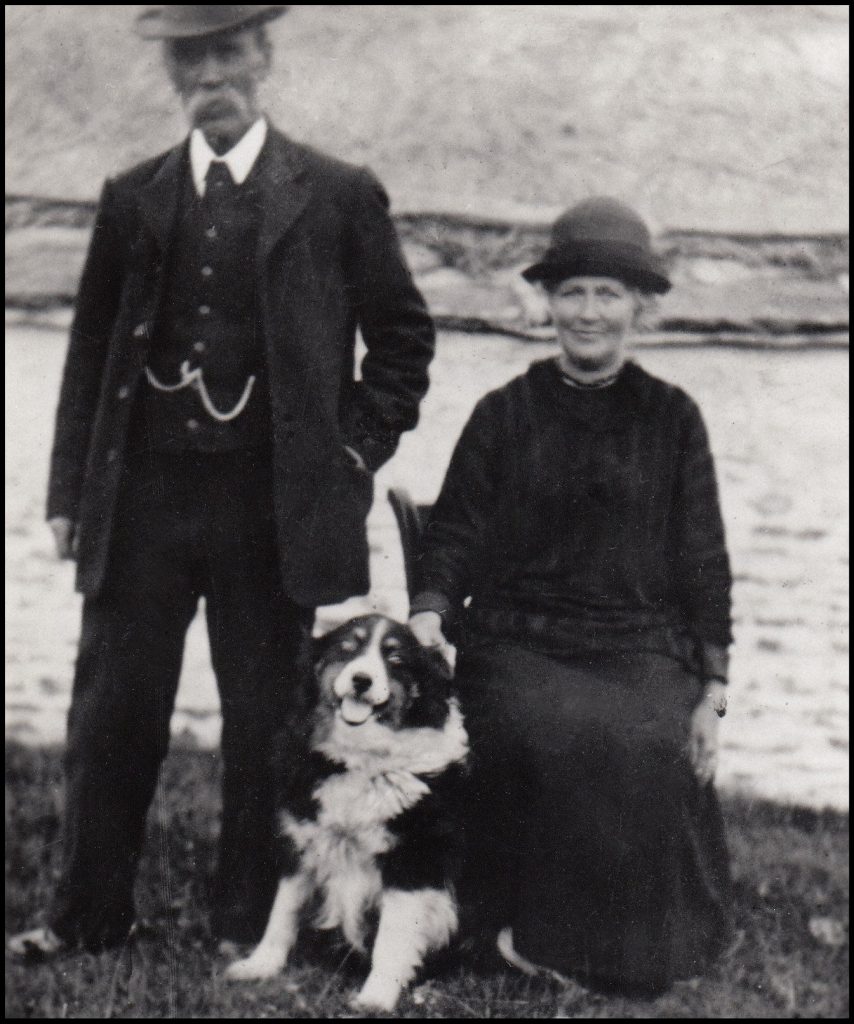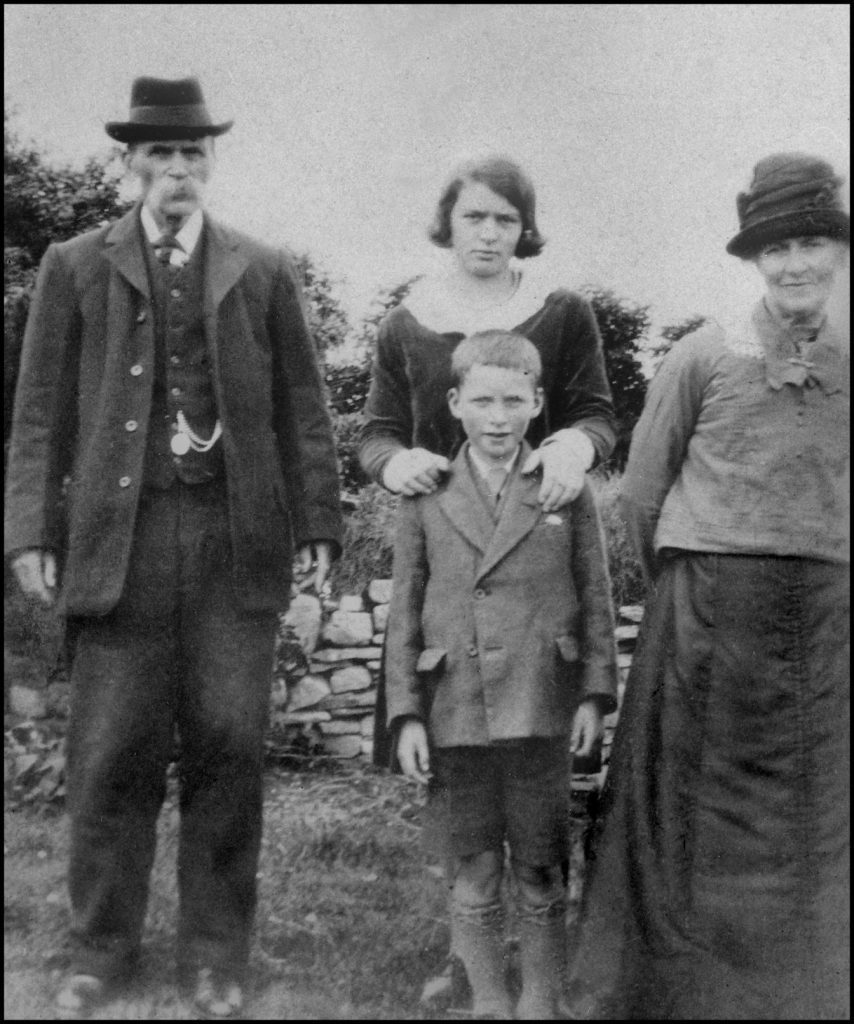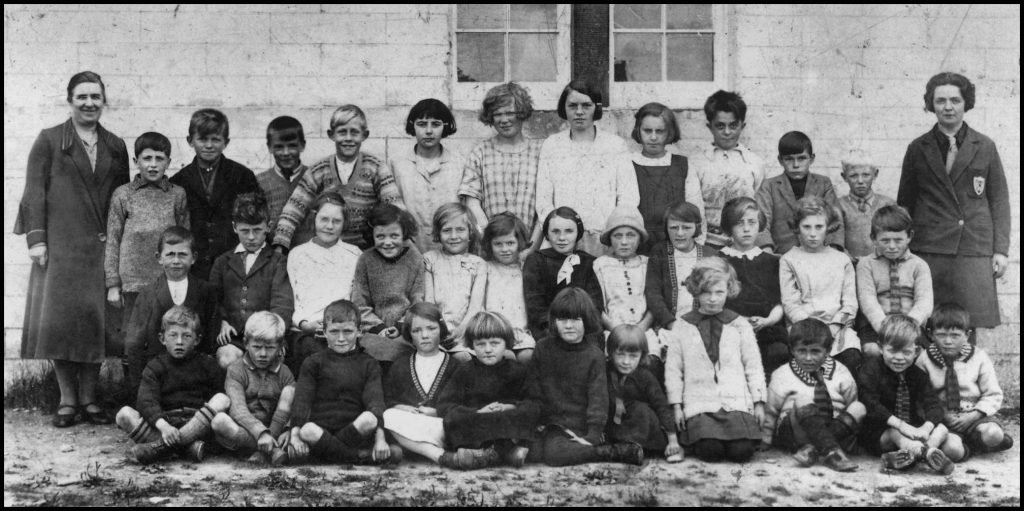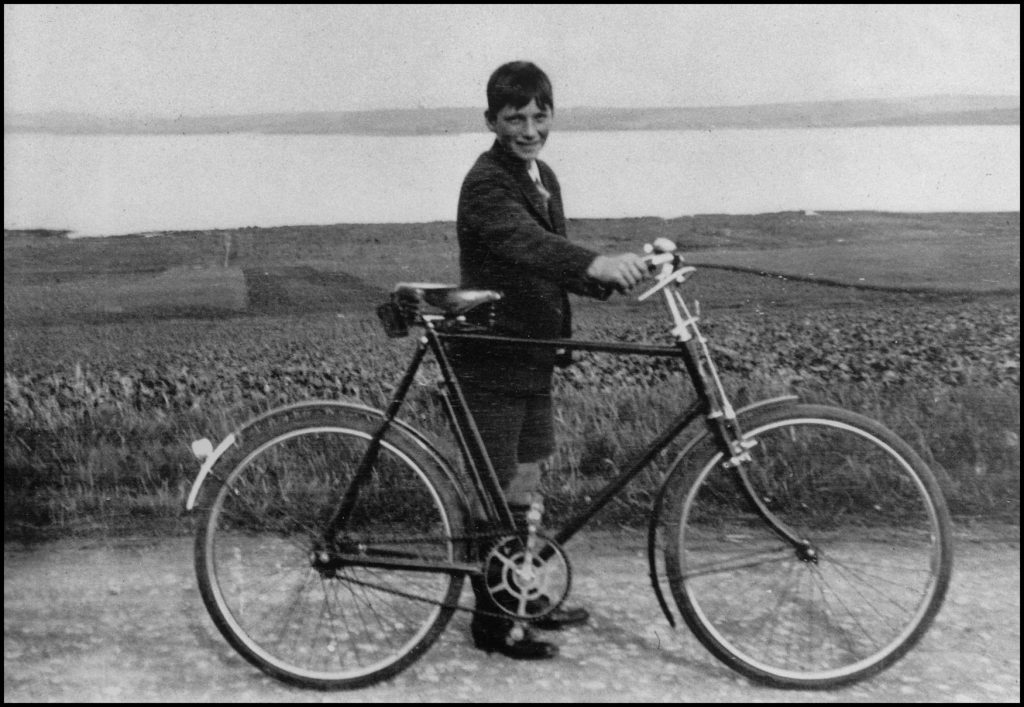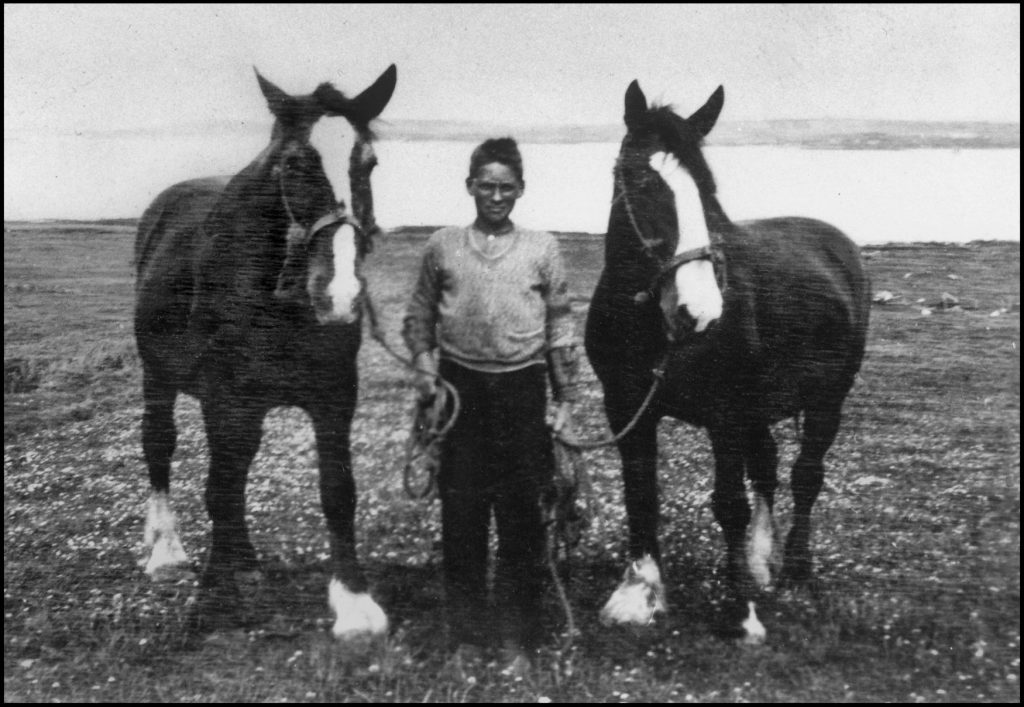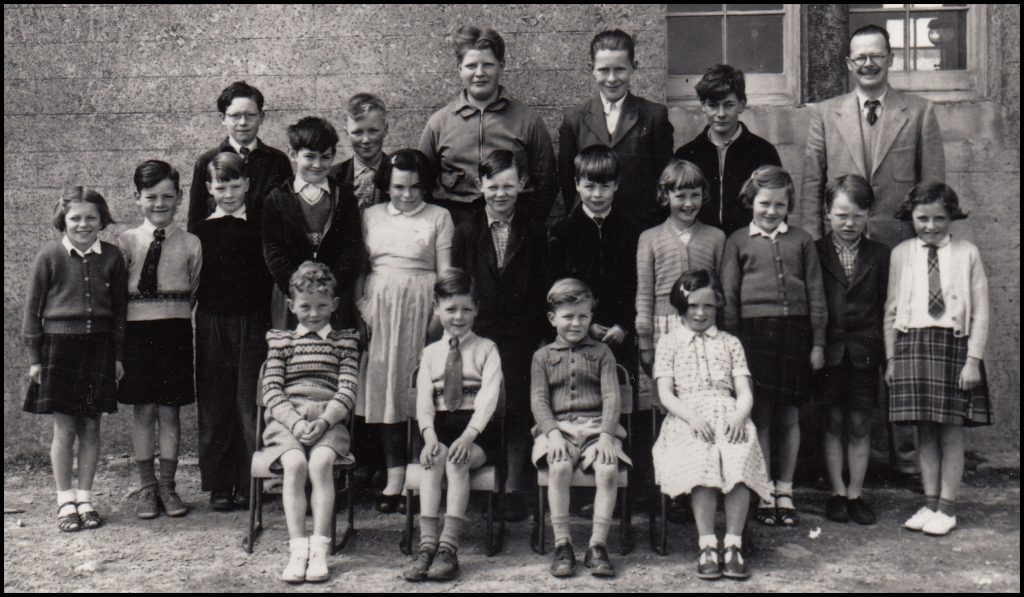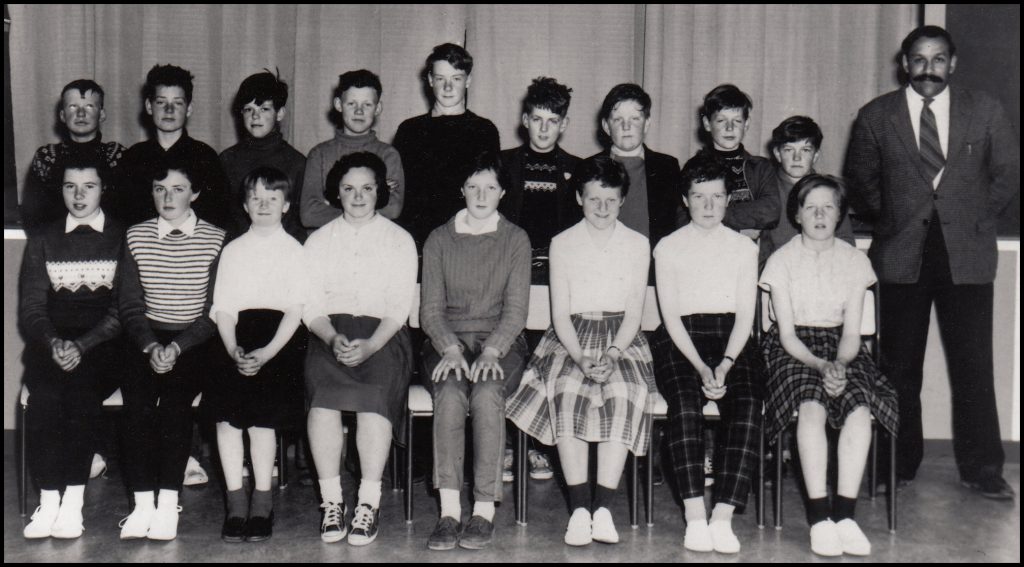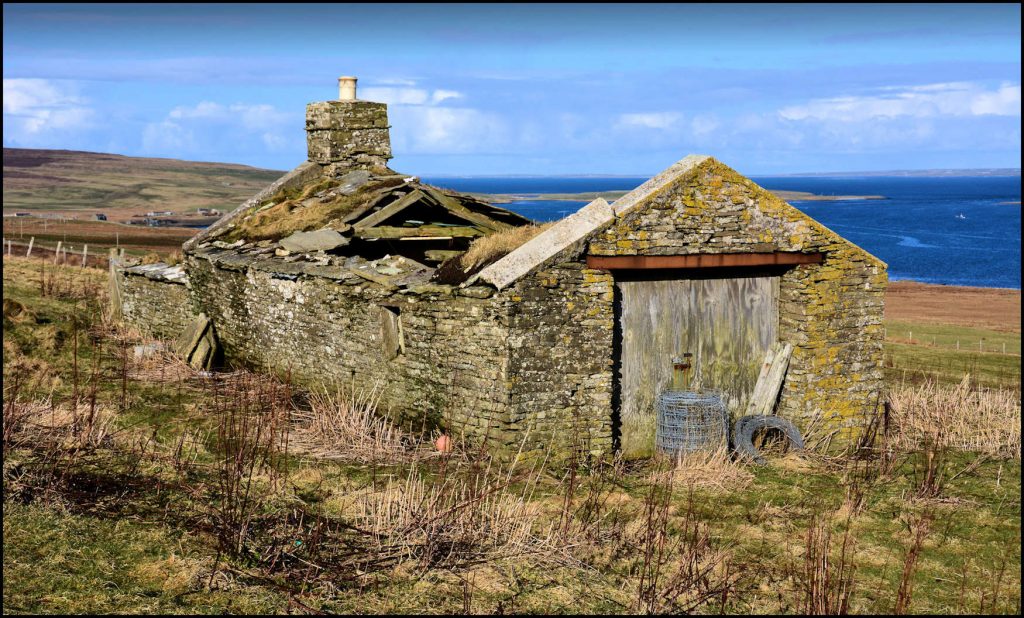by
Phyllis Muir – daughter of Archer and Doll Clouston.
In the Land Valuation records, up until the 1920s, the small croft of Upper Knarston, in the Sourin district of Rousay, was part of the Trumland Estate with various tenants named over the years and latterly William Grieve. However by 1925 the records show him as proprietor. William Grieve appears in the 1871 census, the son of Alexander Grieve and Margaret Harrold living at Nethermill, aged 15 and described as a servant at Skokness (sic). At some stage Willie went to New Zealand but unlike many who emigrated in the late 1800s, he returned. After his return he married Mary Ann Clouston in 1903 and so begins the connection of Cloustons to Upper Knarston. Mary Ann, or Dolly as she was known, was my father Archer Clouston’s great aunt.
Willie and Dolly are pictured below on their wedding day.
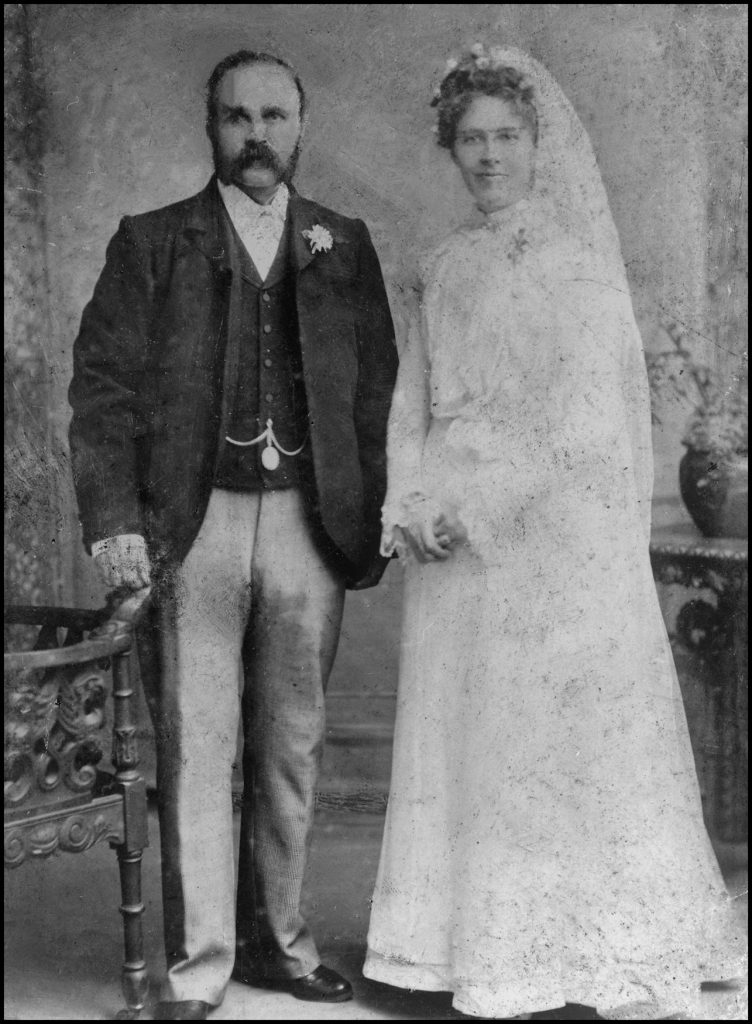
Archer was born in 1923 to Archer snr and Helen Lyon. Archer snr was born in 1887 in Orphir to Jane Maria Clouston, father unknown. Helen Lyon was from Portsoy so how they met I am not too sure. They married in Aberdeen in 1912 and lived in Portsoy where my aunt Jean was born in 1916 and Archer jnr seven years later. The family returned to Stromness in approximately 1927 and sadly Helen died in 1928.
The photos above show Willie and Dolly Grieve with Jean and Archer in the early 1930s.
Archer snr was unable to care for the two young children with the result that they came to Rousay to be looked after by Dolly Grieve, who was Jane Maria’s sister. My Dad told stories of how poor his life was as a youngster but he was cared for. I imagine a lot of his memories must have been emotionally scarred by the loss of his mother at such a young age. In 1945 he married Doll (Annabina) Flaws from Wyre. They first lived at ‘The Stables’ at Trumland House, then, on Dolly Grieve’s death in 1946, he inherited the croft and they moved to Upper Knarston.
Back row: Willie Ferguson, Stand Pretty, Bing Munro, Bravel, Alfred Gibson, Avelshay, Robert Seatter, Banks, Jeanny Donaldson, Broch, Daisy Munro, Bravel, Jean Clouston, Upper Knarston, Annabella Gibson, Pow, Roy Russell, Old School, Bill Mainland, Hurtiso.
Middle row: John Seatter, Banks, James Lyon, Ervadale, Annie Craigie, Essaquoy, Kathleen Munro, Bravel, Kathleen Grieve, Cruannie, Mabel Grieve, Cruannie, Nelly Harcus, Clumpy, Chrissie Russell, Brendale, Kathleen Gibson, Avelshay, Annie Craigie, Scockness, Isabella Lyon, Ervadale, George Craigie, Scockness.
Front row: John Grieve, Digro, Robert Grieve, Cruannie, Archer Clouston, Upper Knarston, Edith Gibson, Avelshay, Maggie Anne Munro, Bravel, Dorothy Mainland, Hurtiso, Netta Russell, Brendale, Anne Lyon, Ervadale, John Harcus, Clumpy, Andy Munro, Bravel, Angus Harcus, Clumpy, and Isobel Grieve, teacher, Fa’doon.
I was born, in 1949, in Upper Knarston, the second-born, being three years younger than my sister, Marlene. In 1955 my brother James was born so there was five of us living in a ‘but and ben’ with a small, sheet iron roofed porch at the front. The sheet iron roof sticks in my mind as I remember in the 1953 hurricane it was in danger of blowing away. Dad tied a rope around parts of it and was clinging on for dear life. The roof was saved!
‘But’, the living end, had the usual black stove, fuelled by peat, which provided all heating and cooking. The first job of the day would be to light the fire and put the kettle on to boil. The kettle would then be set to the side of the stove, but never far from the boil, so always ready to produce a cup of tea, especially for visitors. Bere bannocks were a staple and baked on top of the stove. Getting the right heat was a knack my mother perfected. There were a couple of comfy chairs, a dining table and chairs and a bed in one corner that Marlene and I shared. It was great when we had visitors in the evening as when we went to bed we would pretend to be asleep but often would be listening in to the ‘adult’ conversations that we weren’t supposed to hear! Our parents slept in the ‘ben end’ which I seem to remember had two presses either side of the fire which stored dishes, vases, ornaments and jewellery that had been left by Willie and Dolly Grieve. It seemed a bit of a treasure trove at the time and some pieces still survive to this day. I still wear his gold ring that was made from a nugget that he brought back from New Zealand. The ‘ben end’ in a lot of houses was often the posh room, kept for visitors and Sundays, but we had no space for a room to be unused most of the time and no money to be posh!
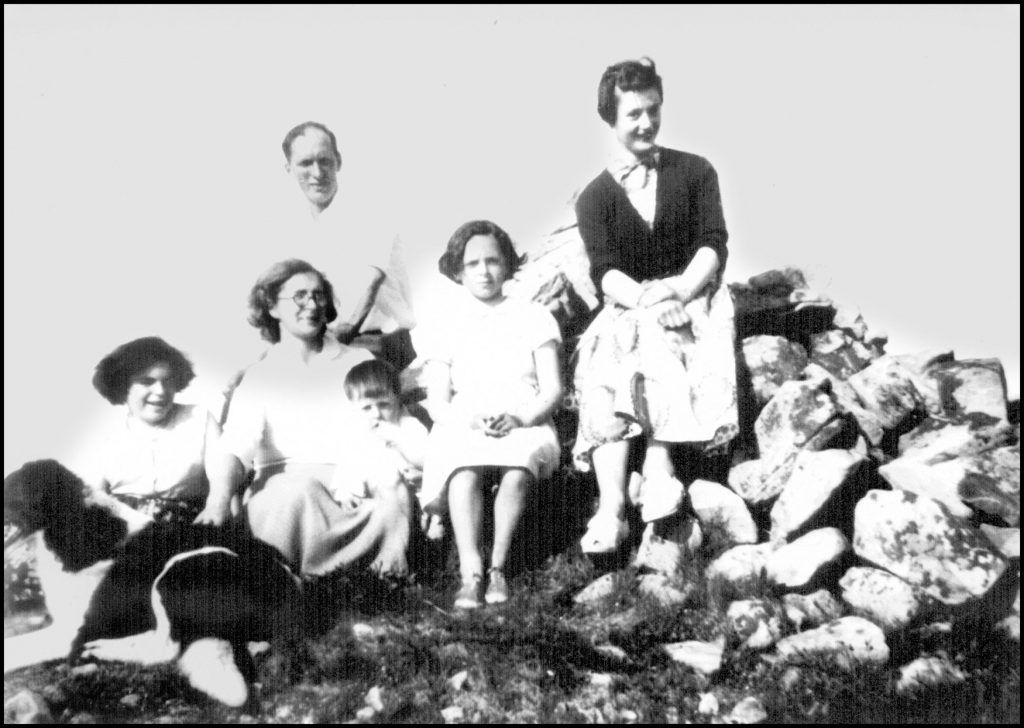
and Doll’s neice Marion Flaws, daughter of Magnus and Mary Flaws of Wyre.
When I was growing up, Upper Knarston, as was the norm at the time, had no toilet. There was a byre that could be used but more often, during the day, relief would be round the corner out of sight of the road! At night there was a bucket in the porch or a po under the bed. Water had to be carried in pails, up the brae, to the house from a well by the roadside. There was no proper road, just a well trodden path across the field. Washing clothes was not a lot of fun, water had to be heated on the fire and poured into an old wash tub with a manual wringer. The only transport we had was a motor bike for Dad and push bikes for Marlene and me. There were a few acres of land around the house but not enough to make a living from so Dad worked at Trumland Farm. We did have a milking cow and a few sheep and hens etc. When the cow came into season Dad had to put a halter on her and lead her along to road to visit the bull at a neighbouring farm. Lambing was also a bit of a chore as the sheep somehow liked to lamb at the top of Knitchen near enough! One of my earliest memories, when I was about 3, is John Mainland of Nearhouse arriving with a sheepdog puppy that we called Ricky – rounding up the sheep became easier after that – he was a lovely dog that lived until I was 18.
Back row, left to right: John Will, Schoolhouse, George Gillespie, Pow, Billy Grieve, Fa’doon, Denis Grieve, Cruannie, Ronald Mainland, Hurtiso, Mr Will, Teacher.
Middle row: Wilma Mainland, Essaquoy, John Inkster, Craigearn, Sinclair Taylor, Avelshay, Tommy Gibson, Broland, Marlene Clouston, Glebe, Kenneth Gillespie, Pow, David Will, Schoolhouse, Sheena Grieve, Digro, Muriel Mainland, Essaquoy, Leslie Gillespie, Pow, Lilian Craigie, Breck.
Front row: Ian Grieve, Digro, Bob Inkster, Craigearn, Bruce Mainland, Hurtiso, Phyllis Clouston, Glebe.
School: When I started school, which meant a mile’s walk there and back, Mr Will was the teacher at the Sourin school. At that time pupils attended from 5 to 15 years old and very few, in my memory, went on to school in Kirkwall from Sourin. Every summer we had a school picnic and every Christmas there was a Christmas concert. I was never very keen on either event as I never won any of the races at the picnic and was too shy to be comfortable on stage! Picnic day attracted a big crowd of parents and visitors and I remember cream cookies and ice-cream as the treats out from the ‘toon’. Santa always came to the Christmas concerts which caused great excitement. There were 3 schools in Rousay at the time but very little communication between the 3. I remember at one stage Sourin pupils were decanted to the Frotoft school where Isabel Grieve of Fa’doon was the teacher. I can’t remember the reason but do remember the rivalry. Frotoft school had 2 well behaved boys at the time and lots of girls.
Back row, left to right: Leslie Gillespie, Pow, John Inkster, Craigearn, Robert Dickey, Langskaill, Kenneth Gillespie, Pow, Sinclair Taylor, Avelshay, Alistair Marwick, Innister, Jimmy Marwick, Cogar, Robert Inkster, Craigearn, Bruce Mainland, Hurtiso, Sandy Nelson, Teacher.
Front row: Doreen Donaldson, Wasdale, Lilian Craigie, Breck, Marcia Marwick, Cogar, Phyllis Clouston, Glebe, Olive Petrie, Tratland, Judy Miller, Wasbister schoolhouse, Doreen Grieve, Saviskaill, Muriel Mainland, Essaquoy.
Sourin had a few rough and tumble boys so I think the calm normally experienced in Frotoft was shattered for the time we were there! When Mr Will left he was replaced by Mr Nelson who was a bit of a character. He owned a landrover and on a nice day, rather than being cooped up in school, he loaded us all in and we went on ‘field trips’. Not sure we learned very much about nature that we did not know already! In 1960 the 3 schools joined so my last year at primary was a different experience. Emphasis was placed on passing the 11+ exams, which I did and gained a place at Kirkwall Grammar. I was not too keen but my father explained that if I did not go my life would be spent cleaning the byres, singling neeps etc – that threat did the trick! At 12 I started school in Kirkwall and spent 6 years in the School Hostel, another experience which I believe is totally different from what school bairns experience today. We did not get home every weekend never mind every night like they do now.
Entertainment: I remember having a radio in the house but any other entertainment was ‘home-made’. On a Sunday we always had to go to the Kirk. Unfortunately we lived in that part of Rousay which was equidistant from the Brinian and Sourin kirks, so we had to go to both! Sunday was a day of rest at that time, reading was allowed but not much else. If it was a fine afternoon it would be a walk to the top of Knitchen or down along the ‘hammers’ below Knarston. Very often, in the summer, Sunday would be the day when we would get visitors, aunties, uncles and cousins from Wyre or Shapinsay. We did not have a phone at Upper Knarston so how all this got arranged I have no idea but there must have been communication as there was always a fine spread of food ready. Visiting friends and relatives at any time of year often meant staying for supper which could be sandwiches (usually tinned salmon!), scones and jam, bannocks and cheese, cakes etc, all along with a cup of tea. Very seldom would alcohol be involved unless there was a home brew on the go around Xmas and New Year. Occasionally whisky would be offered and my father would pour a dram for a visitor but not have anything himself.
In addition to the concerts and picnics, mentioned above, other highlights of the year was the Show, which at that time was agricultural as well as horticultural / industrial and the Harvest Home. Children would attend these dances as well as adults and when they became too tired would be wrapped in coats and allowed to sleep across a couple of chairs. Most of the men would have ordered a ‘half-bottle’ for the event and in between dances small groups of men would disappear outside, returning each time a bit merrier as the evening went on. The women would be seated along one side of the hall, men at the other. It was only when bars were introduced in the 1970s that it become acceptable for women to be seen enjoying a dram as well!
Move to the Glebe: Around 1958, my father decided to branch out on his own and took over the tenancy of the Glebe from Willie Corsie. The Glebe belonged to the Church of Scotland and was situated beside the ministers Manse and was just down the road from Upper Knarston. The house was bigger in that it had a ‘but and ben’ but an additional room at the back and a big wooden extension out the front, painted green so was referred to as the ‘green room’. We also had the ‘luxury’ of an small outside ‘loo’ a hut which had a wooden toilet seat over a pail which had to be emptied on to the midden on a regular basis. It seemed like we had moved up in the world – memories for another day.
[All black and white photos courtesy of the Tommy Gibson collection]
A ‘taster’ to this page was added to the Orkney Past & Present Facebook page.
It prompted the comments below…..
Morag Russell: I did enjoy reading Phyllis’s memories – and my own memories came flooding back! I really don’t know how Auntie Doll did it but I used to bide at Upper Knarston for me holidays – we must have managed 3 lasses in the bed, I suppose! It was a highlight of my year and the food was always fantastic – the grandest of tattles and baking, all cooked on/in the black Enchantress stove, fired by their own peats. And how I used to marvel at the bonny things in the ben end. There were the most beautiful exotic shells, the likes of which I had never seen before. And the smells were different – coming from Shapinsay, where we had no peats, I thought I could smell the Rousay fires before I ever got off the boat. And Doll and Archer always had summer roses with the sweetest scent – they must have been Rosa Rugosa I suppose. I remember Marlene and myself collecting old tins and jars and playing shops by the peat stack. We must have looked like a right pair of urchins! None of us had much and I suppose, by some standards, we were poor but those days were some of the happiest of my childhood and have a very special place in my heart.
Jonathan Paul May: 1st car I owned was a 1959 Austin Cambridge A55 Mk2 bought off Archer for a bottle of whisky in 1981..!
Jimmy Clouston: Well done Phyllis. I was 3 when the folks left Upper Knarston so I don’t have any memories of staying there. I do mind me and Harold Trimble trying to catch pigeons up there and putting holes in the ‘Asbestos’ sheet ceiling in the process. I remember getting a ‘skelped erse’ for that.
Ron Spence: Lovely that was. Enjoyed the read. Not much different to Hammerfield. And I used to enjoy cream cookies as well, artificial cream and all. I haven’t seen one for many years.
Morag Russell: We thought there was nothing better! We’d probably hate them now!
Marjorie Pettigrew: Enjoyed the visit to the past. Brought back memories of Rousay and smell of the peat.
Bertie Gillespie: That was great reading & looking at the photos o the Sourin school. I know all the bairns in the photo. I never seem tae be in any school photos. I think I spent a lot o school days working at Faraclett wae me auntie Maggie Anne and Jock !!
